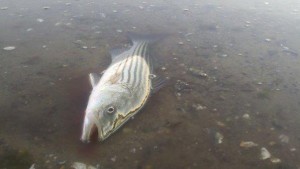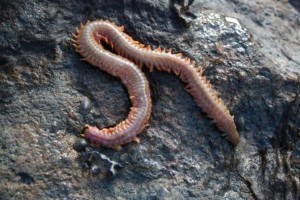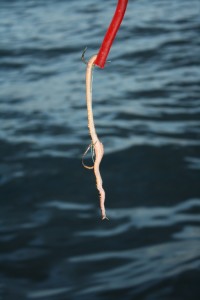*This excerpt has been taken from Tube and Worm Trolling - From the first knot to the gaff shot!
There are quite a few theories floating around about what the tube and worm imitates. It's pretty easy to understand why. What on earth could a two foot long, gyrating piece of rubber, moving slowly through the water column actually resemble in the marine world?
Throughout the years folks have come up with some interesting explanations as to what the tube and worm resembles in nature. One of my favorite theories is that the tube and worm mimics an eel swimming backwards with a worm in its mouth.
I wonder how many times striped bass encounter this scenario in their aquatic environment!
Of course who knows, it is possible that bass believe they are consuming an eel when they bite a tube, however I personally believe this to be rather unlikely. Instead, I like to think that the tube and worm resembles the very creature we tip the tube with-a sandworm.
If we accept that the tube and worm does imitate a sandworm, then we can begin to explain all sorts of striped bass behaviors, which will in turn make us better fishermen and more adept tube and worm trollers.
Let's take a look at why it is reasonable to assume that the tube and worm imitates a sandworm, and how this can help us improve our level of success.
Small Bass Biting Big Tubes
"I got one!" is what I remember saying to my father years ago as we trolled tubes from our small family skiff.
I had just started trolling the tube and worm, and was excited because I knew there had recently been some big bass caught on tubes. This fish, however, was not putting up much of a fight.
"Are you sure you have a fish?" my father asked.
"I think so" I replied, in a somewhat dissapointed tone-realizing that this certainly was not the bass of my dreams.
I remember reeling the line in, half expecting to find a giant clump of weed latched onto the tube. To my surprise I did have a bass-an enormous 18 inch schoolie!
"How the heck did that fish expect to swallow that tube!" asked my father.
I really had no answer for him at the time. We had been trolling obnoxiously large 36 inch long tubes. The bass I had dangling on the end of the tube was barely half the size of the tube it had attempted to digest.
Since that day I have caught many small fish on tubes. Quite a few of these bass had attacked tubes much larger than themselves.

When targeting schoolie stripers, the usual protocol is to "go small." Little jigs, poppers and swim baits typically outfish large pencil poppers, bunker spoons and swimming plugs when it comes to catching bass less than 24 inches in length.
Knowing this, I was puzzled as to why such a small bass would go out of its way to bite such a large offering. If we accept that bass mistake the tube for a sandworm, these "small bass-big tube" instances are a bit easier to understand.
Sandworms are very fragile creatures and break apart easily. A small bass would have no problem nipping away at a large sandworm as it wiggled through the water. A three foot long sandworm represents many small meals for a young, opportunistic striped bass. With this understanding it is easy to see why small bass are routinely caught using large tubes.
With this knowledge it is now clear why the hook is placed at the tail end of the tube. When attacking worms, it is reasonable to assume that bass instinctively nip away, starting at the worm's tail. Conveniently this is where the tube's hook is located.
If bass did not behave in this fashion it would be much harder to hook a bass with a tube. It may even be necessary to place hooks along the entire length of the tube.
Fortunately this is not the case!
Giant Sandworms
Early on in my fishing career, I dismissed the possibility of a tube imitating a sandworm due to the fact that the majority of sandworms I had personally encountered were much shorter in length than the tubes I was trolling. Often times the worms we purchase from bait shops are less than a foot in length.

The vast majority of the sandworms used for bait along the striper coast come from Maine's tidal flats. Hardworking men and women literally dig these worms from the mud during low tide.
Moon phase has a direct correlation to the size of the sandworms available to anglers. During the full or new moon, when the tidal range is the most dramatic, worm diggers have access to areas usually covered by water. Thus they are able to dig up older, bigger worms.
Other moon phases, such as a half moon, do not have such a dramatic impact on the tides. Therefore worm diggers do not have access to the outer reaches of the flats. Thus the worms available in bait shops are usually on the small side.
However the flats that are exposed to worm diggers only represent an extremely small percentage of the sandworm's environment. Sandworms can reside in water as deep as 200 feet-far from the reach of even the most ambitious worm digger. Can you imagine how large these sandworms must grow?
Three and four foot long sandworms are probably very common in the striped bass' environment.
I would imagine that a four foot long sandworm is still on the larger end of the sandworm growth spectrum. This may help to explain why I seem to have the best luck using 18 and 24 inch long tubes-which more than likely represent the majority of sandworms encountered by striped bass.
Tube and Worming During the Dog Days of Summer
Bass are often pretty lazy during the heat of the summer. The same fish that are so aggressive during the spring and fall, often prove very difficult to catch during July and August.
It's not unusual to encounter a large school of bass under the spell of "lockjaw." These fish are in resting mode, and generally refuse even the most well presented offering.

One of the go-to techniques used for catching bass during these tough times is the tube and worm. Often times a properly trolled tube will be the only way of catching these lockjaw bass.
A sandworm, helplessly squirming through the water column must be the easiest prey item to catch on the striped bass' menu. This rings especially true compared to fast moving prey like mackerel, pogies, eels and squid. For a big bass, catching a worm must be about as easy as it gets.
Needless to say it does not require much energy on the bass' behalf to catch a sandworm. Thus the tube and worm often catches lazy bass when no other method is producing.
Tube Colors and Sandworms
I believe it is no coincidence that one of the most popular and productive tube colors is red. Large, healthy sandworms are often bright red in color.
Sandworms also have hints of green, orange and brown spattered throughout the length of their body. This helps to explain why bright orange, green and brown tubes produce bass.
Black tubes may at first seem like an anomaly to this rule. However black tubes, which I religiously use at night, cast a more defined silhouette against the night time sky. This makes it easier for bass to find the tube using their vision. Due to the lack of light, tube color is not as important once the sun goes down.
Swimming Sandworms
Have you ever seen a sandworm squirming through the water?
Sandworms make very slow progress through the weater column. They squirm and wiggle and have an almost uncanny resemblance to a properly trolled tube. Sometimes sandworms swim with a fairly tight wiggle-other times they curl and gyrate.
Check out Tide Pool Time's sandworm youtube video to see sandworms in action. Just click here.

There is no denying that a tube and worm, trolled slowly through the water column, wiggles just like a sandworm.
Scent
Adding a live sandworm, or at least a scented imitation sandworm to the hook of a tube, is absolutely critical. Catching a bass without at least a small piece of sandworm on the tube's hook is extremely rare.
And a small piece of sandworm is really all that is needed to tip a tube. Of course I prefer to tip the tube with a gigantic, fat sandworm-however a small two inch long piece will work just fine. As long as some sandworm scent is emanating from the tube, the tube will fish just fine.
Adding a sandworm to the tube's hook is the icing on the cake for this tube and worm theory. The scent that is produced by the sandworm is the nail in the coffin for striped bass that attempt to swallow that corkscrewing piece of rubber behind your boat.
As always comments are encourage and appreciated.
Tight lines and good luck trolling!
Captain Ryan
Follow My Fishing Cape Cod on Facebook by clicking here.

